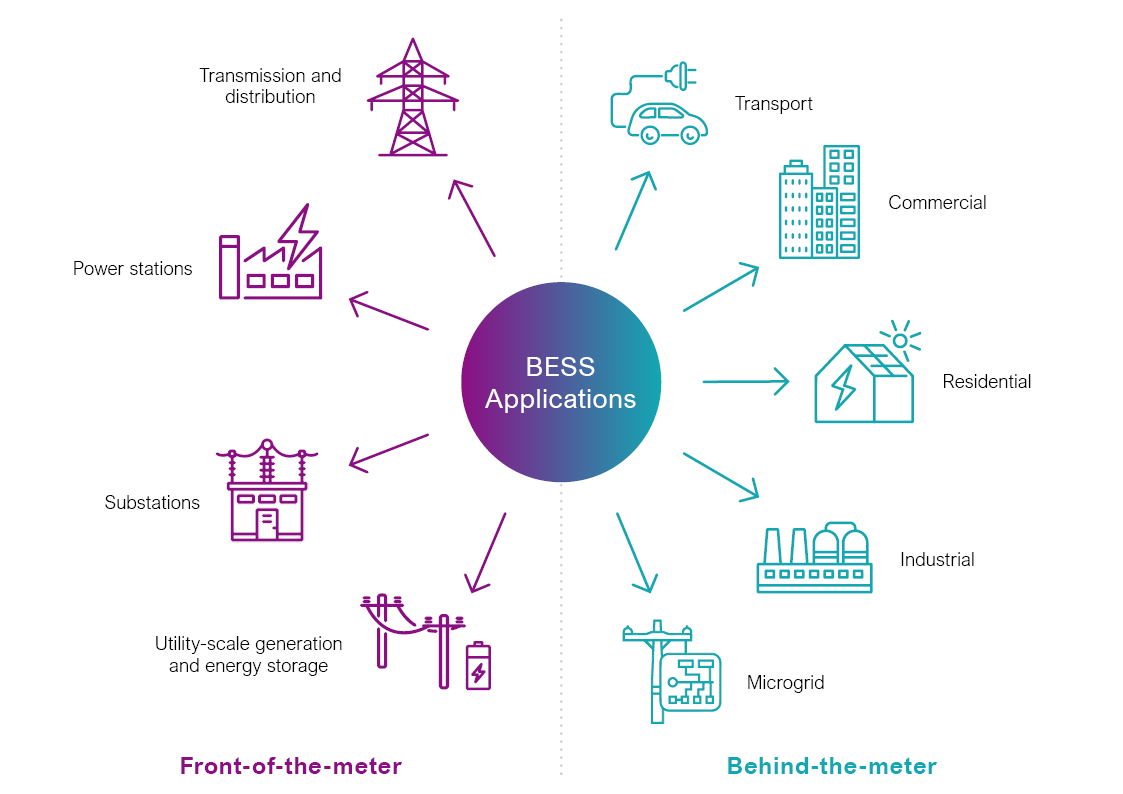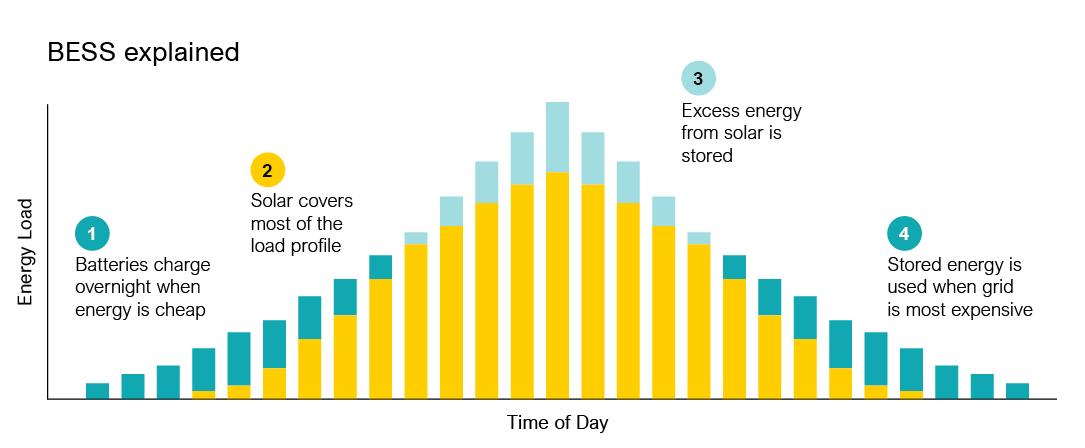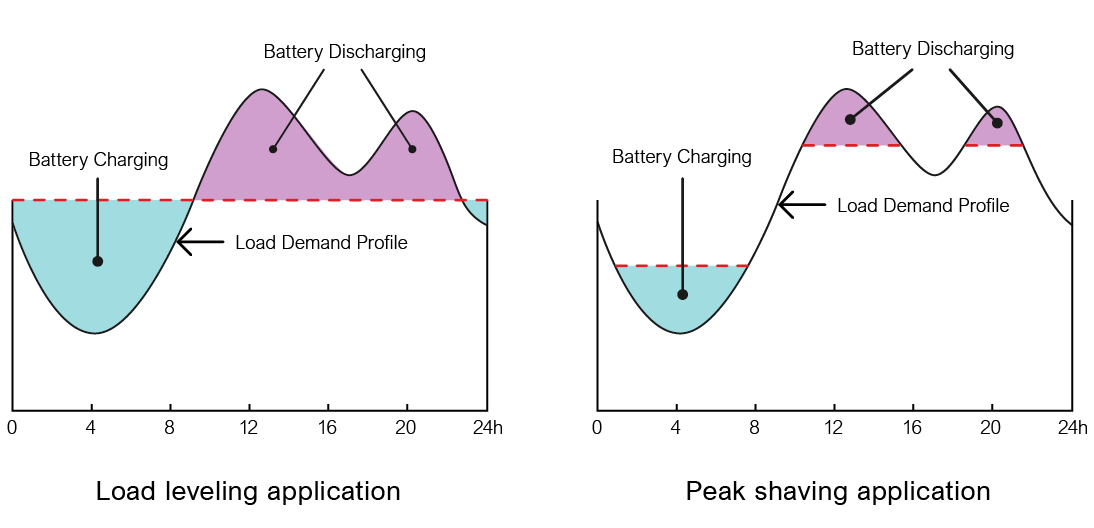A battery energy storage system (BESS) plays a vital role in balancing renewable energy’s intermittency during peaks of demand for electricity. It stores excess energy generated by sources such as solar power and wind during periods of low demand and releases it when needed — ensuring grid stability and preventing outages.
As we shift toward clean energy, battery storage systems have become key to integrating renewables into the grid.1 By smoothing out the energy supply from intermittent renewable sources, BESS enhances grid reliability, reduces reliance on fossil fuels and helps lower carbon emissions, making it a crucial player in the energy transition.
The brief history and evolution of BESS technology
The introduction of lithium-ion batteries in the late 20th century was a game changer. With their higher energy density, faster charging times and longer lifespan, lithium-ion batteries transformed BESS from a niche technology to a scalable solution for grid-level energy storage. As a result, BESS began to play a more significant role in renewable energy projects.
Key milestones in BESS development include the rise of grid-scale batteries in the 2000s, when pilot projects like the Tehachapi Wind Energy Storage Project in California (2008) and the Hornsdale Power Reserve in South Australia (2017) aimed to enhance grid stability, along with further technological advancements in battery management systems (BMS) and power conversion systems.2+3 These innovations made BESS more cost-effective, reliable and scalable.
Today, newer battery chemistries and technologies are set to push the boundaries even further, offering improved safety, readily available materials, efficiency and long-duration storage capabilities, cementing BESS’s role in the global energy infrastructure.4
Components of BESS

Source: Neteon
1. Batteries
The core of any BESS is the battery itself. Lithium-ion batteries dominate the market due to their high energy density, rapid dispatch capability, and efficiency, making them ideal for short and medium-duration applications like frequency regulation.
2. Power conversion systems
Inverters and converters manage the energy flow between the battery and the grid, and more recently directly between the solar and the battery (DC-coupled/Hybrid). Inverters convert the stored DC energy into AC power for distribution, while converters regulate the charging and discharging cycles, ensuring smooth, bidirectional energy flow. These systems are critical for preventing damage to the battery cells and maintaining grid stability.
3. Battery management system (BMS)
The BMS is crucial for monitoring the state of charge (SOC), voltage, current and temperature of the batteries. It prevents issues like overcharging and deep discharging, both of which can shorten battery lifespan.5 Modern BMS solutions often include real-time data analytics and predictive maintenance features, allowing operators to address potential issues before they impact performance. Continuous monitoring ensures the system operates efficiently and safely.
How does BESS work?
This process allows a BESS to perform various power management strategies that improve the efficiency of renewable energy use and reduce dependence on fossil fuel-based systems:
- Load shifting: This strategy allows energy to be stored during low-demand periods and used when demand is higher. By capturing excess renewables and redistributing it throughout the day, load shifting maximises the efficiency of energy use and reduces reliance on fossil fuels.
- Peak shaving: Peak shaving kicks in during times of high demand, discharging stored energy to ease pressure on the grid. By reducing the immediate load, it helps avoid costly grid overloads and limits the need for fossil fuel-based power generation.
Source: ResearchGate
The role of BESS in renewable energy integration
Battery energy storage systems are fundamental to ensuring grid stability and reliability as renewable energy takes on a larger share of electricity generation. Renewable sources like solar and wind are inherently variable — solar peaks in daylight hours, while wind generation can fluctuate depending on weather conditions. Without a way to manage these variations, integrating renewables on a large scale would be challenging. This is where BESS steps in and provides a cleaner path forward.A core function of BESS is frequency regulation — keeping the supply and demand of electricity balanced in real time. When the grid experiences shifts in demand, such as during a heatwave when air conditioning use spikes, BESS can respond instantly, stabilising voltage levels and smoothing out power fluctuations. This quick response capability makes BESS invaluable in preventing outages and ensuring a steady power flow, even in times of unexpectedly high demand.
Beyond grid stability, BESS plays a crucial role in managing the intermittency of renewables. Solar energy, for example, generates the most power during the day, but electricity demand tends to peak in the evening. Places like South Australia and California are prime examples of places where BESS is taking a significant piece of the evening impact off of the list of challenges for grid operators in regions with very high solar adoption. Similarly, wind energy generation can be inconsistent, making it difficult to align supply with real-time demand. BESS addresses these challenges by storing surplus energy during periods of overproduction and releasing it when renewable output falls short or when demand increases.
By doing so, BESS reduces the need for fossil fuel-based backup power — a key contributor to carbon emissions.6 To date, natural gas has been providing the service needed to mitigate the challenge of renewable intermittency. As countries become rightfully hesitant to deploy more fossil fuel generation in the face of climate change to accommodate this, BESS is used to meet the challenge, enhancing the efficiency of the entire system. This is critical in supporting the energy transition and reducing overall reliance on fossil fuels.

Source: CyberGrid
What are the benefits of BESS?
The benefits of BESS extend well beyond simply integrating renewable energy. At its core, BESS is about optimising energy — capturing surplus energy when it’s available and ensuring it’s put to good use when it’s needed most. This kind of efficiency is crucial to achieving both sustainability goals and reliable power systems.
Globally, energy storage deployment has seen remarkable growth. In 2023, battery deployment in the power sector alone more than doubled, adding 42 GW of storage capacity, compared to 17 GW in 2022.7 This represents a significant increase in global storage capacity, highlighting the essential role BESS plays in stabilising energy systems and supporting the transition to renewables. Looking ahead, a sixfold increase in global energy storage capacity is needed by 2030, with 1,200 GW expected to come from battery systems, to meet climate and energy goals.8
BESS offers a range of benefits:
- Reducing emissions: BESS optimises the use of renewables by storing excess energy, reducing the need for fossil fuel power generation. This helps lower carbon emissions and supports global climate targets.
- Boosting energy security: BESS ensures reliable backup power during grid outages, protecting critical sectors like healthcare, infrastructure and industry. It stabilises power flow, preventing disruptions during peak demand.
- Cost savings: BESS enables strategies like load shifting and peak shaving, storing energy during low-cost periods and releasing it when electricity prices spike, helping both businesses and households save on energy costs.
- Strengthening grid stability: BESS provides essential grid services such as frequency regulation and voltage support, helping to stabilise grids with high levels of intermittent renewable sources, reducing the need for traditional backup power.
- Minimising waste: BESS captures excess renewable energy generated during low-demand periods and stores it for use when demand is higher, maximising energy efficiency and reducing waste.
The combination of these benefits — ranging from reducing emissions to enhancing reliability and delivering cost savings — makes BESS a critical element of our energy future. As the world continues to invest in clean, resilient energy systems, BESS will remain at the forefront, helping to build a more sustainable future for everyone.

Source: Voltio
Challenges and considerations
Despite its benefits, deploying battery energy storage systems presents several challenges. A key issue is battery degradation over time, particularly for lithium-ion batteries. As batteries age, their storage capacity and efficiency decrease, leading to higher maintenance costs and shorter lifespans. This is a critical consideration for large-scale energy storage projects that require long-term reliability.Another challenge is the integration of BESS with existing energy infrastructure. Grid compatibility and synchronisation with renewable energy sources can be complex, especially in large-scale deployments. Ensuring that battery systems work in harmony with solar and wind power sources, for instance, requires careful planning and coordination to avoid technical mismatches.
Additionally, safety risks such as thermal runaway — a condition where batteries overheat and potentially cause fires — remain a concern, requiring rigorous safety protocols during deployment and operation.
Adhering to evolving safety standards and regulations is crucial for the safe and reliable operation of BESS. As battery storage systems become more common, meeting these requirements is key to reducing risks and ensuring long-term success.

Source: McKinsey & Company
Future trends in BESS
Looking ahead, advancements in battery technology will shape the future of BESS and include the following trends:
- Long-duration and grid-scale storage: Increasing demand for longer storage times and grid-scale applications is driving innovation, enabling renewable energy to meet the needs of a more reliable, resilient grid.
- Advanced software and AI integration: Predictive analytics and AI are enhancing system efficiency, improving maintenance and optimising the use of stored energy.
- Recycling and sustainability: Emphasis is growing on sustainable recycling solutions and environmentally responsible disposal for end-of-life batteries, reducing the overall environmental impact.
Source: Beca, Glenbrook BESS
Key takeaways
Battery energy storage systems are key to the future of renewable energy, offering the flexibility and reliability needed to integrate clean sources like wind and solar into the grid. By stabilising the grid, cutting reliance on fossil fuels and strengthening energy security, BESS is accelerating the global shift to sustainable energy.As battery technology evolves, BESS will play an even larger role in building a more efficient and resilient energy system. To learn more about how Beca is helping shape the future of energy storage, reach out to our team today.
Sources:
- Australian Energy Council - Battery Storage: Australia's current climate
- ResearchGate - Tehachapi Wind Energy Storage Project: Description of operational uses, system components, and testing plans
- Hornsdale Power Reserve - Home
- ScienceDirect - Next generation sodium-ion battery: A replacement of lithium
- Supreme Solar Power - A new era of solar storage: exploring the potential of sodium-ion batteries
- Federal Batteries - What is Depth of Discharge and why is it so important?
- ScienceDirect - Fossil Fuel Combustion
- IEA - Rapid expansion of batteries will be crucial to meet climate and energy security goals set at COP28

